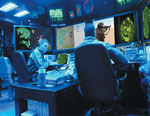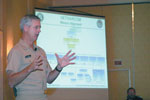Restructuring Boosts Navy Information Sharing
 |
| The new alignment of responsibilities at the Naval Network Warfare Command (NETWARCOM) will enhance the service’s command and control abilities, increase maritime security and facilitate seamless communication. |
An ongoing U.S. Navy realignment is uniting defense and intelligence tasks to permit missions based on both service-specific and national capabilities. The changes are accelerating the convergence of the service’s command, control, communications, computers, information operations and space asset capabilities. This will enable component commanders to be more proactive in hunting down maritime threats.
The evolution began in September 2005 with the integration of the Naval Security Group (NSG) and its subordinate commands into the Naval Network Warfare Command (NETWARCOM),
Vice Adm. James D. McArthur Jr., USN, commander, NETWARCOM, explains that merging the NSG into the command particularly will benefit the Navy in the area of information operations. “NSG used to be an Echelon 2 command under the chief of naval operations located in the National Capital Region. Now it’s been subsumed by NETWARCOM, which has given NETWARCOM the opportunity to bring those skill sets into full mission alignment for support to Navy component commanders,” he says.
Coordination between the intelligence community and the Navy will help the military dominate the battlespace, especially in the information domain, the admiral states. Attaining this dominance was more difficult under the previous structure. “The alignment of the information operations mission for the Navy under NETWARCOM led to the merger of the NSG with its mission of information operations and, historically, cryptology. This brings together Title 10—man, train and equip—with Title 50—intelligence.
“If you look at the force, the people in [the NSG], it’s a mix of Navy-funded billets and
Assembling these capabilities under the NETWARCOM umbrella is important because the command’s responsibilities comprise three elements and a complex mission set. The command is a functional, operational commander that supports the Navy’s component commanders as well as joint commanders. In that capacity, it serves as the service’s component commander of the U.S. Strategic Command. In addition, NETWARCOM carries out traditional force commander responsibilities that accommodate its type commander tasks as well as its third role as the chief executive officer of the Naval NETWAR/FORCEnet Enterprise.
The admiral relates that the service already has reaped some benefits from aptly fusing functionalities but notes that it has only scratched the surface. “There’s much more potential there as we continue to hone the tactics, techniques and procedures and the doctrine,” he states.
To ensure that this capability can be used most effectively, the Navy must first define information operations and determine in which phase of a campaign they should be applied. “Is it phase 0? Is it phases 1 and 2? For our purposes, information operations are anything relative to computer network operations, electronic warfare, strategic communications, military deception and psychological operations. So it’s exploitation; it’s defense and protection; it’s even a hack; it’s supporting influence operations as in information operations, particularly in phase 0. So it’s pretty broad and complex,” Adm. McArthur maintains.
The best way to describe the new alignment of responsibilities is that NETWARCOM is taking all the functionality of the former NSG and applying it in new ways, he says. This includes computer network defense, planning and operations, and assessment for naval component commanders. “It’s also to the point where that Title 10 and Title 50 mix ensures that there’s a commander who is responsible and accountable to present certified forces—cyber warfighters, information warfighters—to operational commanders whether Navy or joint. In general terms, that’s how we have seen some early benefits from it,” the admiral relates.
This reconfiguration is about more than just shuffling tasks. The service has multiple Navy Information Operations Commands (NIOCs) and
“Those relationships didn’t exist in the past. Now there are service and national capabilities that are merged in one area. When a FIOC solution is offered, it really is a blended solution, and you bring the capacity of the NSA and national support directly to a Navy component commander,” Adm. McArthur explains.
The Navy has invested in adding capabilities and attaching itself to the cryptologic centers so that it can capitalize on the NSA’s input. It is streamlining its processes and tailoring the product to support its component commanders. “It’s not a matter of abusing or misusing the Title 50 side of the operation. It’s a matter of attaching yourself to that blended solution of Title 10 and Title 50 and providing the best of both worlds,” the admiral notes.
For example, NIOC–Georgia at
 |
| Vice Adm. James D. McArthur Jr., USN, is the commander of NETWARCOM. |
The investment in capacity now includes NIOC direct support at the operational level. “The NIOCs, under a different organization and name, have been extremely effective in terms of tactical-level support. But we’re elevating their game—particularly in planning and assessment—to the operational level, and that’s where this investment has occurred. We think this has great utility and will provide greater options for our Navy component commanders.
This is all consistent with maritime security, which really has its pedigree all the way up to the National Strategy for Maritime Security. It has that linkage as part of it,” Adm. McArthur explains.
This move into the operational space will help the Navy shift from being reactive to being proactive. For instance, commanders who spotted a contact of interest in the past would relay the information to NIOCs and request that they monitor the situation. Under the new construct, this process gets turned on its head. When NIOCs find contacts of interest, they will pass that information to the commanders. The contact of interest could be any type of threat, from weapons of mass destruction to terrorists to piracy. “We feel the information is there; the data is there. But it’s a matter of sorting, sifting, racking and stacking it, being in the battle rhythm of a Navy component commander and presenting those contacts of interest,” the admiral says.
Supporting operations in this way requires more than just sharing information, he adds. The NIOC commander must understand the mission, intent and battle rhythm of the specific component commander as well as the dynamics within the area of responsibility, operational risk, and planning and assessment cycles. Particularly in information or influence operations, the NIOC commander also must appreciate the full scope of the diplomatic, information, military and economic implications for each country and the entire region in the area of responsibility.
“Our expectations are pretty high here, but we have the capacity. The information domain, the battlespace, demands that we provide this capability and expertise, and that’s being achieved predominantly through the former NSG and its new alignment with NETWARCOM,” Adm. McArthur states.
In addition to these changes, NETWARCOM’s 2006-2010 strategic plan calls for certifying the MOCs. The Navy has several centers that support component commanders, and the command is now taking them to the next level by increasing the uniformity within and among them. This standardization will affect how the personnel operate as well as the command, control, communications and computer systems, resources, functionality, networks and applications. It is aimed at enabling the MOCs to pass information seamlessly worldwide.
Certification of the MOCs is only one of six goals in NETWARCOM’s strategic plan. In addition, the plan calls for the command to operate as the service’s component of the Global Information Grid as a weapons system; to extend and optimize the use of information operations capabilities, including signals intelligence; to ensure that the Navy fully leverages and influences space capabilities; to develop the work force to achieve information superiority; and to implement the command’s components of FORCEnet.
These goals are based on direction from the chief of naval operations to Navy leaders to apply effects-based thinking (EBT) across the service. “EBT is a process that involves beginning with the end in mind. The NETWARCOM strategic plan, with its emphasis on the top six measurable effects, is important. It provides a strong focus on warfighter readiness and shows an organizational commitment to exceeding expectations. EBT facilitates aligning those actions and activities needed across the domain to reach that common end,” the admiral explains.
Growing its support of both naval and joint activities requires a substantial staff, and as with the other services, the Navy has integrated reservists into its operations. NETWARCOM has nearly 800 reservist sailors supporting various command functions and initiatives, and 18 NETWARCOM sailors from the Navy Reserve have been recalled to
Reservists are assisting the command with integrating the overseas Navy Enterprise Network, or ONE-NET, in
But reservists are not the only group that is helping the command fulfill its mission. The admiral notes that NETWARCOM also heavily depends on industry partners to bring it the latest technology, particularly commercial solutions. “Our Trident Warrior Sea Trial experiment series has been very productive in this area. We have accelerated a number of technology initiatives as a result of our partnership with industry in Trident Warrior and will be conducting Trident Warrior 2007 in the spring in the Virginia Capes Operating Area,” the admiral says.
Although Trident Warrior has helped move technology to the Navy quicker, the admiral admits that it is not quite the speed to market that the command would like to see. “But it does help us in terms of fielding solutions sooner than we have before. We’re all for compression; we’re all for speed, accuracy and assuredness of our networks. Industry has been helping us with that,” he says.
Web Resource
Naval Network Warfare Command: https://ekm.netwarcom.navy.mil/netwarcom/nnwc-nipr/index.htm



Comments